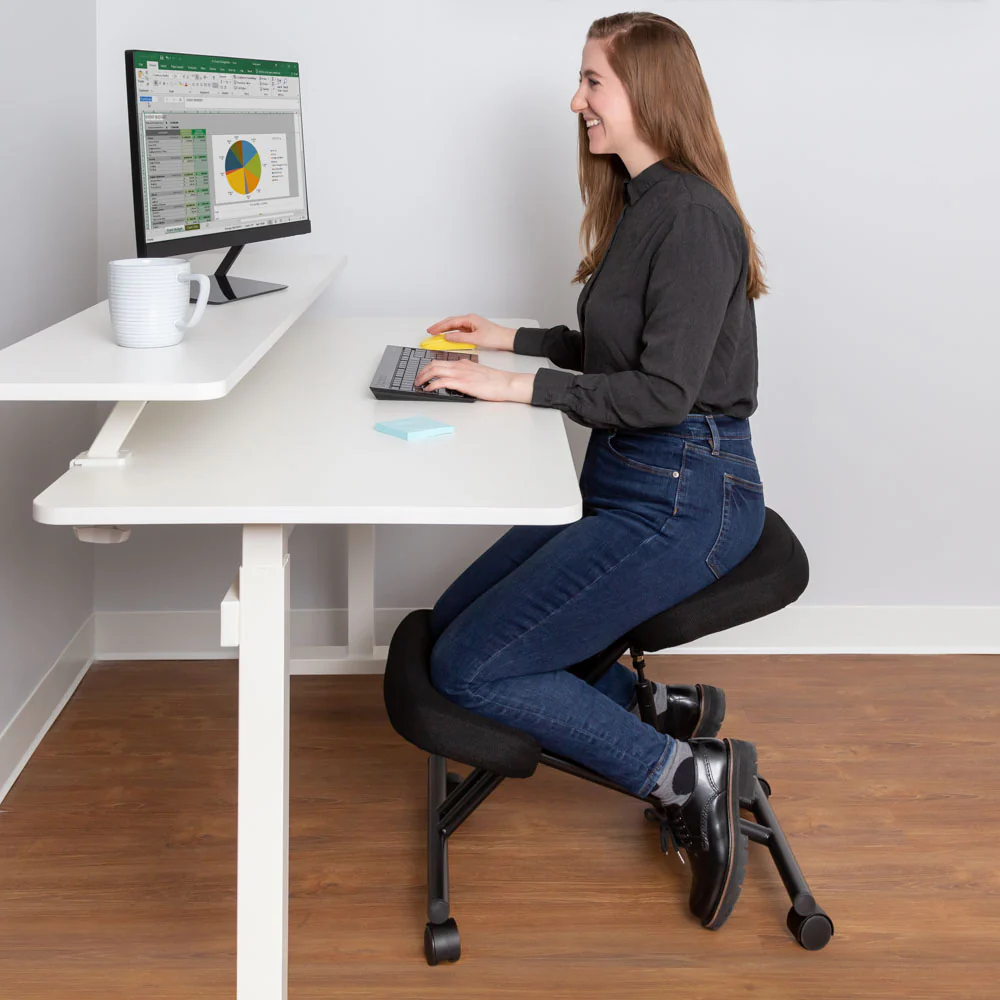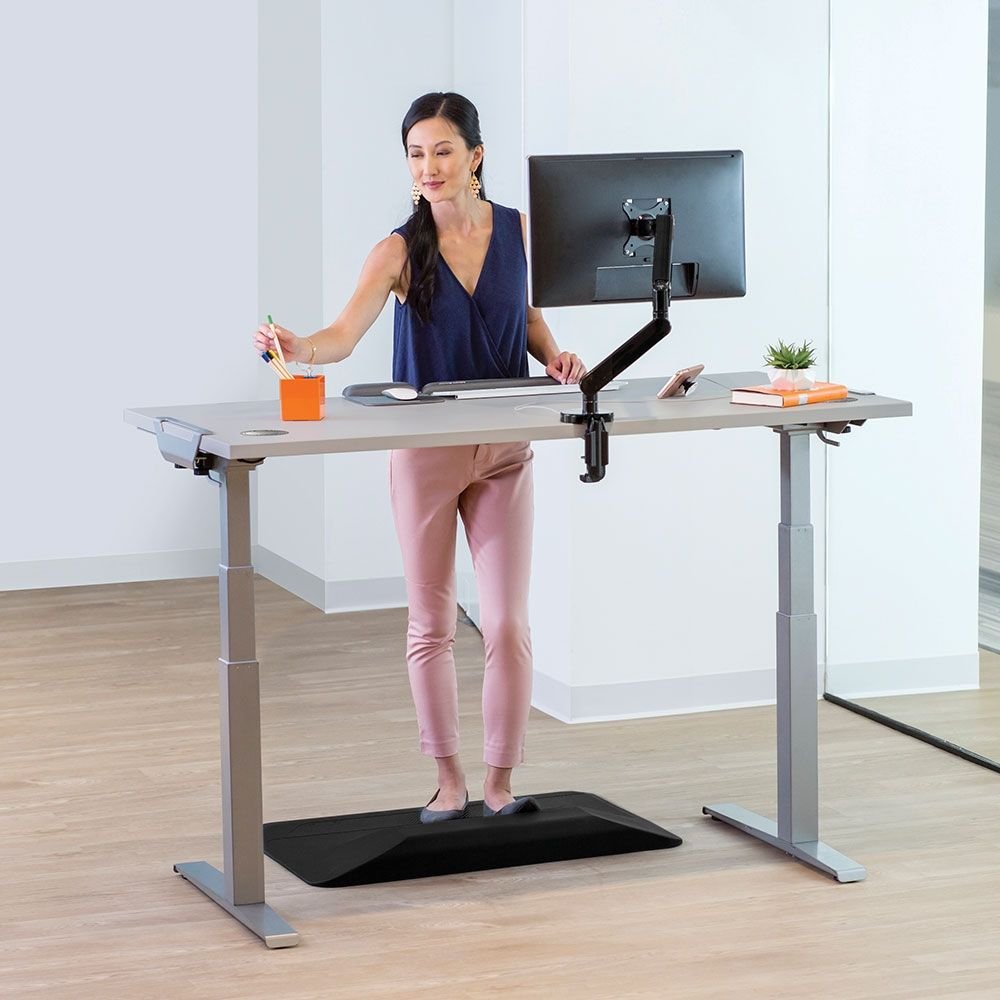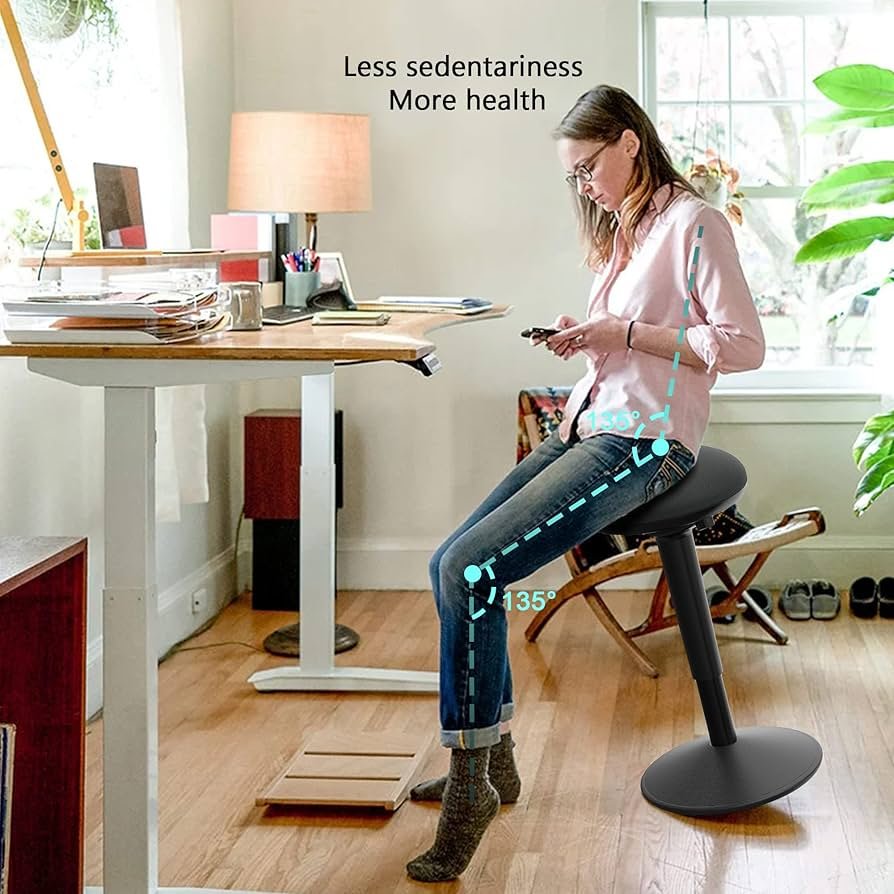Standing desks have become a significant feature in modern work environments, reflecting a broader trend towards fostering healthier and more dynamic workplaces. Originally introduced to combat the sedentary nature of traditional desk jobs, standing desks offer a practical solution for enhancing both physical well-being and productivity.
The basic premise behind standing desks is to reduce the amount of time employees spend sitting, thereby decreasing the risk of ailments associated with prolonged sitting, such as obesity, cardiovascular disease, and musculoskeletal issues.
An increasing number of studies highlight the health benefits associated with using a standing desk. For instance, alternating between sitting and standing can help to improve posture, mitigate lower back pain, and boost overall energy levels.
Furthermore, the simple act of standing can enhance circulation and encourage subtle movements that help burn calories throughout the workday. These health improvements not only benefit the individual but can also have positive repercussions for the organization, such as reduced absenteeism and higher levels of employee engagement and productivity.
As awareness of the negative impacts of sedentary lifestyles grows, more people are turning to standing desks as a preventive measure. The rise in popularity is also driven by advancements in ergonomic design and technology, making standing desks more accessible and customizable to individual needs.
Modern models often come with adjustable settings, allowing users to switch between sitting and standing positions with ease, and are designed to accommodate various work setups, from single monitor setups to complex multi-monitor configurations.
The increasing prevalence of standing desks underscores a shift towards more dynamic workspaces that prioritize employee health and well-being. As companies continue to recognize the value of health-oriented office solutions, standing desks are likely to remain a central component in the evolving landscape of modern work environments.
This blend of health benefits and enhanced productivity serves as the foundation for the growing adoption of standing desks in today’s work culture.
Benefits of Using a Standing Desk
Using a standing desk has garnered significant attention in recent years, primarily due to its comprehensive health and workplace benefits. One of the foremost advantages is the improvement in posture. Regularly alternating between sitting and standing can help align the spine, thereby reducing the risk of musculoskeletal disorders.
Many experts affirm that standing desks encourage a neutral position, reducing the strain on the lower back and discouraging the slumped posture often associated with prolonged sitting.
Increased energy levels are another considerable benefit of integrating a standing desk into one’s daily routine. Standing promotes better blood circulation and reduces the lethargy that comes with extended periods of sitting.
A study published in the “Journal of Environmental and Public Health” indicated that employees who used standing desks reported higher energy levels and less fatigue over the workday. This enhancement in physical well-being contributes directly to improved mental alertness and engagement.
Moreover, standing desks are linked to a reduction in back pain, a common complaint among office workers. By promoting movement and decreasing the time spent in a static position, standing desks can alleviate pressure on the spinal discs and surrounding muscles.
Research, including a 2018 study from the “American Journal of Preventive Medicine,” has shown that participants with standing desks experienced significant reductions in chronic back pain over several weeks compared to those who remained seated.
The productivity boost from using a standing desk cannot be understated. Standing, as opposed to sitting, can enhance cognitive functions and productivity metrics. A report from the “International Journal of Workplace Health Management” underscored that employees using standing desks exhibited greater task engagement and efficiency.
The study highlighted that the physical shift from sitting to standing can break monotony, promote greater focus, and catalyze quick and decisive thinking, essential for dynamic work environments.
In summary, standing desks offer multiple benefits, from improved posture and elevated energy levels to reduced back pain and enhanced productivity. With robust backing from research studies and expert opinions, the standing desk stands out as a beneficial addition to modern workplaces, aiming to foster greater health and efficiency.
Potential Risks and Drawbacks
While standing desks promise numerous benefits, they also come with potential risks if not used correctly. Prolonged periods of standing can lead to some physical discomforts and health issues. One of the most common problems associated with extensive standing is sore feet. When you stand for long durations, the pressure exerted on your feet can cause pain and discomfort, sometimes leading to more severe conditions like plantar fasciitis.
Another significant concern is leg pain. Standing for extended periods can put strain on your lower limbs, particularly your knees and hips. This can result in muscle fatigue and joint pain, which may affect your overall posture and mobility. Moreover, remaining stationary in a standing position for too long can impede proper circulation, potentially leading to swelling and discomfort in the lower extremities.
Furthermore, varicose veins can be an unfortunate consequence of prolonged standing. Standing for extended stretches forces your veins to work harder to pump blood back to the heart. Over time, this can lead to the development of varicose veins, which are not only unsightly but also painful and uncomfortable. The risk of developing these veins increases if you already have a family history of the condition or other predisposing factors.
Medical experts recommend incorporating a balanced routine to mitigate these risks and drawbacks. Dr. John Doe, a renowned ergonomic specialist, suggests alternating between sitting and standing every 30 to 60 minutes.
Additionally, using an anti-fatigue mat can help reduce the pressure on your feet, while compression stockings may assist in improving circulation and preventing varicose veins. Regular movement, stretching exercises, and proper footwear are also essential to maintain comfort and health when using a standing desk.

How Long Should You Stand?
When using a standing desk, determining the optimal duration for standing is crucial for maximizing health benefits while minimizing discomfort. Health organizations and ergonomic experts provide various guidelines to help establish a balanced approach. According to the experts, alternating between sitting and standing can enhance productivity and reduce the risk of musculoskeletal disorders.
Health organizations, such as the American Heart Association, recommend standing for around 15 minutes every hour. This helps to combat the adverse effects of prolonged sitting, which include increased risks of cardiovascular diseases and obesity. Ergonomic specialists suggest incorporating multiple standing intervals throughout the day to promote better posture and overall well-being.
The concept of the sit-stand work ratio is central to effective use of a standing desk. Experts advocate for a 1:1 or 2:1 ratio, meaning for every 1 to 2 hours of sitting, an individual should spend approximately 30 to 60 minutes standing. Implementing this ratio can help in maintaining energy levels and reducing fatigue.
To implement this, you might begin by standing for 5 to 10 minutes every half hour and gradually increase this as your body adjusts. This incremental approach ensures that the transition to using a standing desk is smooth and sustainable. Regularly alternating between sitting and standing positions encourages movement, which is beneficial for circulation and muscle engagement.
Incorporating reminders or using desk timers can be practical tools to maintain a consistent sit-stand pattern. Adjustable standing desks can also facilitate this alternation, making it easier to switch between sitting and standing positions without interrupting workflow.
In conclusion, standing for a recommended duration at a standing desk, guided by the sit-stand work ratio, contributes significantly to reducing sedentary behavior and promoting ergonomic health. Adapting these recommendations to personal comfort and work routines can lead to improved overall well-being and productivity.
Factors Influencing Standing Duration
The ideal duration to stand at a standing desk is influenced by a variety of individual and situational factors. One primary element is age; younger individuals may find it easier to stand for extended periods, while older adults might require more frequent breaks to reduce strain on joints and muscles.
Health conditions also play a critical role. Individuals with specific ailments like chronic back pain, arthritis, or varicose veins might need tailored advice from medical professionals to determine a suitable standing-sitting balance.
Another significant factor is the nature of work tasks. Administrative duties that involve prolonged typing or detailed focus might necessitate more frequent transitions between sitting and standing. Conversely, tasks that allow for more mobility or require physical activity could benefit from longer standing periods.
The type of footwear and the use of ergonomic accessories, such as anti-fatigue mats, can also impact comfort levels while standing, potentially extending the duration one can maintain the position comfortably.
Individual comfort levels vary greatly and should not be underestimated. Personal preferences, body composition, and prior experiences with standing desks contribute to how long one should stand. It is essential to listen to one’s body and avoid pushing through pain or discomfort, as this can lead to negative health outcomes. Shorter, more frequent standing intervals are often recommended to mitigate fatigue and promote optimal circulation.
Incorporating natural movement and periodic adjustments can enhance the benefits of a standing desk. Alternating between sitting, standing, and light walking every 30 to 60 minutes is generally advised to maintain bodily health and focus. Tailoring the standing desk experience to align with these factors ensures a harmonious balance, promoting productivity and well-being in the long term.
How to Transition to Using a Standing Desk
Transitioning from a traditional desk to a standing desk requires a strategic and gradual approach to ensure comfort and productivity. One of the most effective methods is to slowly increase standing time. Begin by standing for 15-30 minutes each hour and gradually extend the duration as your body adapts. This incremental approach prevents fatigue and helps build endurance, making your adaptation to a standing desk smoother.
Choosing the appropriate standing desk setup is crucial for a successful transition. Adjustable standing desks offer versatility, allowing you to switch between sitting and standing effortlessly. This variability supports a balanced workflow and minimizes the strain associated with prolonged standing. Consider the desk’s height range to ensure it accommodates your stature, both in sitting and standing positions.
Ergonomics play a significant role in maximizing the benefits of a standing desk. Incorporate anti-fatigue mats into your setup to reduce the pressure on your feet and lower limbs. These mats provide cushioning, encouraging subtle movements that aid blood circulation and reduce muscle discomfort.
Similarly, supportive footwear is essential to mitigate the impact on your joints. Opt for shoes with adequate arch support and cushioning to enhance your standing desk experience.
Reorganizing your workspace to foster an ergonomic standing posture is equally important. Ensure that the monitor is at eye level to prevent neck strain, and the keyboard and mouse should be positioned at or slightly below elbow height for optimal hand placement. This setup minimizes the risk of repetitive strain injuries and promotes a healthy standing posture.
By following these guidelines, transitioning to a standing desk can be a positive shift that enhances your overall well-being and productivity. Take the time to listen to your body, make necessary adjustments, and incorporate ergonomic accessories to create a comfortable and efficient standing workspace.
Exercises and Stretches to Support Standing Desk Use
For individuals who have integrated a standing desk into their workspace, a series of specific exercises and stretches can significantly enhance comfort and posture. These activities are particularly beneficial in mitigating discomfort associated with prolonged periods of standing, ensuring that users remain both productive and healthy.
Firstly, practicing calf raises can be highly effective. By lifting up onto your toes for a count of two, then slowly lowering your heels back to the ground, you can improve circulation and reduce fatigue in your legs. Aim to perform 15 to 20 repetitions every hour.
Next, incorporate hamstring stretches to loosen up these large muscle groups. Stand up straight and gently bend forward at your hips, attempting to touch your toes without bending your knees. Hold this stretch for 20 to 30 seconds, feeling a gentle pull along the back of your legs. Repeat this stretch two to three times throughout the day.
For a versatile, quick stretch, the quad stretch is exemplary. While standing, grab your ankle and pull your heel towards your buttocks. Hold onto a chair for balance if necessary. This stretch targets the front thigh muscles and can prevent stiffness from arising. Maintain the stretch for 15 to 20 seconds on each leg, repeating twice daily.
Another crucial activity is shoulder rolls. By rolling your shoulders forward and backward in a circular motion for about 10 repetitions each direction, you can alleviate tension and promote better posture. This simple exercise helps counteract the hunched shoulders that can occur from consistent desk work.
Lastly, performing gentle neck stretches can reduce strain. Slowly tilt your head towards one shoulder until you feel a stretch along the opposite side of your neck. Hold this position for 20 seconds before gently tilting your head towards the other shoulder. Repeat three times for each side.
Implementing these simple, office-friendly exercises and stretches while using a standing desk can significantly alleviate discomfort and enhance overall posture. Engaging in these habits regularly will contribute to a healthier and more productive workspace environment.
Conclusion and Best Practices
Incorporating a standing desk into your daily routine can significantly improve your health and productivity. However, it is crucial to strike a balance between sitting and standing to maximize these benefits. Over the course of this blog, we have explored the recommended durations for standing, essential ergonomic guidelines, and the importance of regular movement.
Experts suggest that you should aim to stand for about 15 to 30 minutes per hour while using a standing desk. This ratio ensures that you avoid the pitfalls associated with prolonged sitting and standing. It’s beneficial to start slowly, gradually increasing your standing time as your body adjusts. Transitioning too quickly can lead to discomfort or even injury. Utilizing a timer or dedicated software to remind you can be an effective way to integrate standing periods into your workflow.
Ergonomics play a vital role in the efficacy of a standing desk. Ensure that your desk is set to the correct height, keeping your elbows at a 90-degree angle and your computer screen at eye level. This setup helps maintain proper posture, reducing the risk of neck and back strain. Consider using an anti-fatigue mat to provide additional support and lessen the impact on your legs and joints.
Remember, movement is key. Static positions, whether sitting or standing, can lead to muscle fatigue and other health issues. Regularly shift your weight, change your posture, and incorporate stretches or brief walking intervals into your routine. Standing desks are not a one-size-fits-all solution, and individual needs may vary, so listen to your body and make adjustments as necessary.
Ultimately, a balanced approach to using a standing desk can foster a healthier, more productive work environment. By gradually increasing standing time, maintaining proper ergonomics, and integrating regular movement, you can reap the full benefits of this invaluable tool. Adhering to these best practices will enable you to harness the potential of a standing desk, promoting well-being and efficiency in your daily activities.









